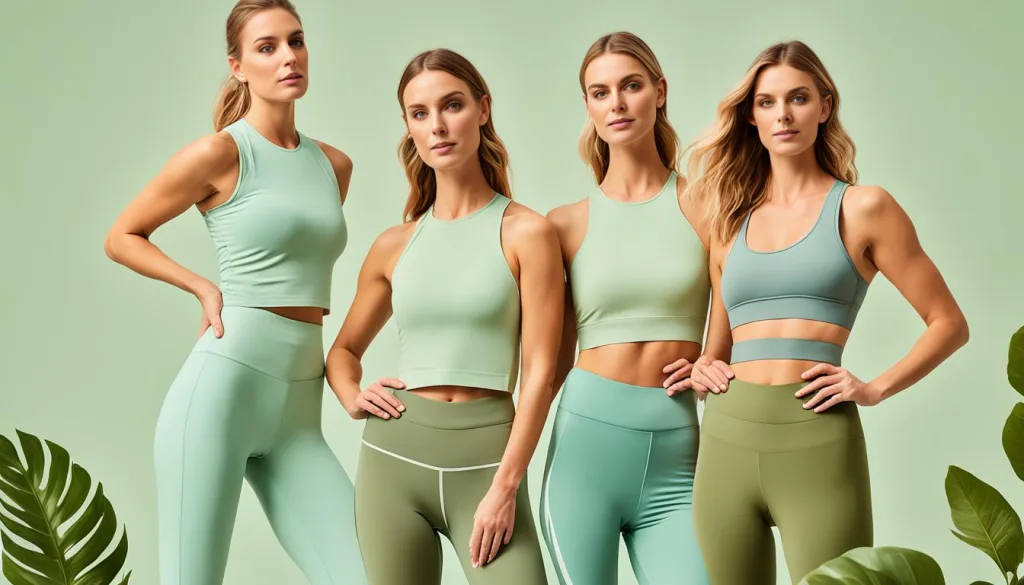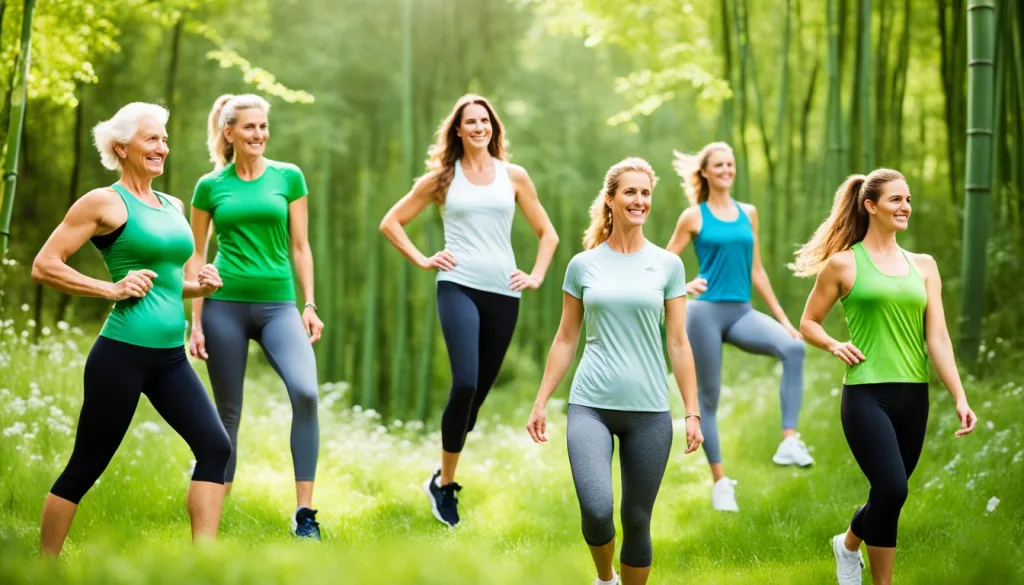Insights into the Growing Demand for Eco-Friendly Sportswear
Connect With Us Today
Consider us for your next production run. Why wait? Send us your questions here.
A new wave of awareness is changing the game in sports fashion. People now prefer clothes that don’t harm the planet. The fashion world, once known for using a lot of water—about 200 tons for each ton of fabric1—is changing. It’s moving to make sports clothes in a way that helps the planet and cuts down CO21. At the same time, what people like and buy is shaping the industry. Studies show that being part of a community makes people more likely to buy green gym clothes1.
The Booming Activewear Market and Sustainability Shift
The demand for green sports clothes is growing fast. This is part of a bigger change in how we buy things. Americans spend more than $14 trillion every year2. A lot of them, over 60%, want to buy things in eco-friendly packaging, a survey in 2020 found2. This has made green products grow quickly, making up nearly half the sales in some areas2.
Key Takeaways
- Shifting market dynamics demand eco-friendly materials in sportswear to address significant environmental impact1.
- Growth in the activewear market is increasingly propelled by eco-conscious preferences and innovations12.
- Consumer willingness to pay more for sustainable products is fostering a market rich in opportunities2.
- Eco-friendly sportswear aligns with the lifestyle aspirations of diverse demographic groups2.
- Forward-thinking brands are prioritizing sustainability offerings to meet consumer expectations1.
The Booming Activewear Market and Sustainability Shift
The activewear market is flourishing because people care more about health and the planet. This part of fashion is growing in size and importance. Sustainable products and the demand for them are pushing this growth.
The Current Landscape of the Activewear Market
Today, the activewear market is vibrant and full of different products. It fits an active life and cares for the environment. By 2019, it made USD 79.41 billion and will keep growing until 20273.
More people living in cities want clothes that last and are good for the planet. North America is a leader in this market with a big share in 2019. It invests a lot in making clothes in a better way3. There’s a clear trend towards buying eco-friendly sports clothes.
Consumer Demand Sparks Eco-Friendly Innovations
Many new eco-friendly products are coming out. People are willing to pay more for sustainable goods. Fashion meets function in popular items like shirts and yoga pants3.
Online shopping for these products is growing fast. Yet, in 2019, most sales were still made in stores3. Brands are told to focus more online to meet changing shopping habits.
| Region | 2019 Market Share | Projected Growth |
|---|---|---|
| North America | 34.1%3 | Stable3 |
| Asia Pacific | Data N/A | Fastest-growing3 |
| Global Urban Population | 55.714%4 | Rising4 |

Looking at the trends, it’s clear the activewear market is moving towards a greener future. Consumer choices and brands are coming together to make a positive impact.
Key Drivers of Eco-Friendly Activewear Popularity
The athleisure market is booming, now worth over USD$350 billion5. Consumers want eco-conscious athletic apparel. About 75% of U.S millennials think sustainability in clothes is key. They lead this market6. In the UK, one in four people would pay 15% more for eco-friendly sportswear7.
People are choosing eco-friendly activewear because they care about the planet. They aim to reduce harmful effects on nature and animals. Brands like Nike and Adidas are taking note, using more recycled materials7. Adidas even sold over 500 million shoes made from ocean plastic waste in 20196.
The UK’s demand for sustainable sports clothing is changing the fashion game. Thanks to new laws, companies must show how they’re fighting climate change7. This opens doors for brands to focus on sustainability and recycling. Hence, offering products that can be reused or donated is becoming popular7.
Mainstream retailers like The GAP and Adidas are growing their online activewear sales. Companies like ASOS and lululemon are also seeing a rise in sales5. This growth shows how important activewear has become. It’s not just about clothes. It’s about marketing, health, and identity too5.
| Consumer Segment | Preferences | Expected Growth |
|---|---|---|
| Millennials | Eco-friendly, Comfort, Style | Increase as brands cater to sustainable choices6 |
| Women | Female-specific activewear, Body confidence | Surpass activewear for men, as brands prioritize women’s lines5 |
| Ethically Minded Consumers | Low GHG, Renewable Resources, Ethical Practices | More sustainable options, with brands helping consumers understand impacts7 |
Eco-friendly activewear is becoming more popular. Brands that prioritize the planet will lead the market. The athleisure market could reach USD 250 billion by 20266. Staying in tune with consumer needs will keep brands on top.
Insights into the Growing Demand for Eco-Friendly Sportswear
Activewear’s global market is soaring, driven not just by style but by deep environmental care among buyers. In the US, spending heads past $14 trillion yearly. Much of this goes to goods showing care for the planet. Now, a huge 78% of US shoppers stress the importance of living sustainably. This changes how they buy, with over 60% valuing eco-friendly packaging2.
The trend of athleisure blends comfort with versatility beautifully. It goes beyond gym wear to fit a casual brunch, showing the impact of the athleisure trend on sustainable athletic apparel. It’s a fashion choice that echoes green living. Surprisingly, wealthy families and those in cities or suburbs are leading the way in preferring eco-conscious products, expanding the market for eco-friendly sportswear2.
From Comfort to Consciousness: The Athleisure Trend
Athleisure captivates with its mix of style and practicality. It’s more than a trend; it’s a lifestyle choice reflecting consumer beliefs. Studies show, products with ESG claims grow faster than their counterparts, highlighting their strong market presence2.
Social Media’s Role in Shaping Eco-Active Lifestyles
Social media undeniably shapes our eco-fashion choices. It’s a powerful platform where sustainable brands can shine. It brings together a community ready to adopt eco-friendly sportswear as part of their daily lives.
Diverse Consumer Base and Global Market Expansion
The trend towards sustainability is rich and evolving, appealing to different consumers. It shows massive growth in various food and personal-care categories. This shift towards environmentally friendly activewear is seen worldwide, attracting families keen on green living2.
In many areas, ESG claims have sped up product growth. This global movement underscores the powerful and lasting impact of making eco-friendly choices2.
| Segment | Percentage with ESG Claims Growth | ESG-related CAGR Advantage |
|---|---|---|
| Food Categories | 73% | 1.7% |
| Personal-Care Categories | 75% | 1.7% |
| Total CPG | 56% | 1.7% |
These strong trends and stats show a clear message from consumers. They demand goods made thoughtfully and sustainably. This is a sign of a society leaning towards eco-friendly sportswear, ready and eager for green options in their activewear choices2.

Technological Advancements and Eco-Conscious Material Innovations
The blend of sustainability and technology is sparking growth in eco-friendly activewear. By 2030, its market value is expected to hit US$ 33.05 Billion from US$ 7.80 Billion in 2023. This jump is due to a 22.9% yearly growth rate8. The boom is driven by sustainable fabric innovations and technology improvements in eco-sportswear. North America will lead, holding more than 35.6% of this market in 2023, with Europe not far behind8.
This growth has changed how people view sportswear. Everyone wants gear that blends performance, style, and eco-awareness. The Asia Pacific region is set to grow the fastest, with a growth rate over 16.5%, showing the huge interest in technological advancements in eco-friendly activewear8.
Eco-aware consumer habits are shaping the market too. From 2020 to 2021, rental gear usage rose by over 25% worldwide. This shows a lean towards circular fashion that supports sustainable fabric progress8. Partnerships in the industry are making an impact as well. The use of sustainable materials in brands linked with the Sustainable Apparel Coalition grew by 30% in three years8.
| Year | Global Sustainable Fashion Market Size (US$ Billion) | Asia Pacific CAGR |
|---|---|---|
| 2023 | 7.80 | N/A |
| 2030 (forecast) | 33.05 | >16.5% |
In retail, India expects a 40% yearly increase in digital shopping. This reflects how digital growth affects market trends8. Innovation and sustainability are changing not only our clothes but the world’s market landscape.
The future looks bright for activewear, thanks to new technologies and eco-friendly materials. As people make more eco-conscious choices, the industry is poised for further growth. The creative and technological efforts in eco-conscious sportswear materials are leading this change8.
Conclusion
More and more, we see a shift towards eco-friendly fashion, especially in activewear. We are learning that our clothes and shoes greatly harm the environment. They use about 200 tons of water for every ton of fabric and add a lot to CO2 emissions. This is driving the push for clothes that are kind to the planet1. The blend of social media, the athleisure trend, and growing green awareness means people want sustainable, effective, and stylish clothes.
But, finding truly green fashion can be tough. Even though advances in technology and materials help make clothes more eco-friendly, there’s a gap in what people say and what they do. About 65% of people say they care about the planet, but few shop with this in mind9. Brands need to be clear about which products are really green. This helps consumers, especially as they get older and find it harder to spot the eco-friendly options9. It’s vital for fashion labels to highlight their green choices to help and educate their customers.
The future of sportswear is green. Studies show that many shoppers will pay more for clothes that don’t hurt the planet. Also, designing clothes to last longer is getting popular, promising a brighter future for fashion19. Focusing on the whole buying process is key to making a change, using the power of community to influence what people buy1. Looking ahead, the trends in sports clothing are moving towards a world where creativity, eco-responsibility, and customer wishes come together. This marks the start of a new era in activewear.
FAQ
What is driving the demand for eco-friendly sportswear?
What materials are used in eco-friendly activewear?
How are brands responding to the demand for eco-friendly sportswear?
How are technological advancements contributing to eco-friendly activewear?
Is the demand for eco-friendly sportswear expected to continue growing?
Source Links
- https://www.mdpi.com/2071-1050/12/7/2788
- https://www.mckinsey.com/industries/consumer-packaged-goods/our-insights/consumers-care-about-sustainability-and-back-it-up-with-their-wallets
- https://www.grandviewresearch.com/industry-analysis/sustainable-athleisure-market
- https://www.fortunebusinessinsights.com/sportswear-market-102571
- https://www.ncbi.nlm.nih.gov/pmc/articles/PMC8203820/
- https://www.mdpi.com/2071-1050/13/14/7946
- https://www.mckinsey.com/industries/retail/our-insights/in-search-of-fashions-sustainability-seekers
- https://www.coherentmarketinsights.com/industry-reports/global-sustainable-fashion-market
- https://www.bain.com/insights/how-brands-can-embrace-the-sustainable-fashion-opportunity/
Latest News
How Collaboration Shapes Consumer Preferences in Sportswear
Navigating Consumer Rights and Warranties in Sportswear Sales
Artificial Intelligence in Fashion Forecasting and Trend Analysis
The Shift Towards Inclusive Sizing in Sportswear: Consumer Reactions
The Global Expansion of Luxury Sportswear Brands
From Sketch to Gym: The Design Process of Fashionable Sportswear
Understanding the Role of Trade Associations in Sportswear Compliance
How Economic Trends Influence Consumer Spending on Sportswear
Learning from Successful Global Market Entries
Best Practices for Managing Cross-Cultural Teams
Using Technology to Fight Counterfeit Fashion Products
Carbon Nanotube Fabrics for Superior Strength and Flexibility
The Growth of Fitness Tracking Apparel in Health and Wellness
Exploring the Influence of Social Proof in Sportswear Purchasing
Strategies for Managing Compliance in a Multinational Operation
Trends in Global Footwear: Performance Meets Lifestyle
The Role of Artificial Intelligence in Tracking Supply Chain Operations
Evaluating the Success of Sportswear Collaborative Projects
Evaluating the Potential of Emerging Markets
Global Shifts Towards Gender-Neutral Sportswear
Share This Article
Latest Articles



















